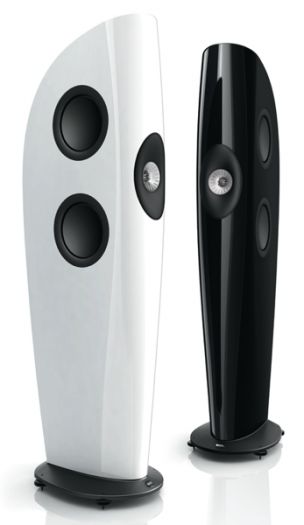British loudspeaker manufacturer, KEF, has a pretty strong track record; they are celebrating their 50th anniversary in 2011, and have been making some great products of late. Their Uni-Q technology has been implemented in dozens of models which have earned high praise from the audio reviewing press around the globe. KEF has always been a leader when it comes to driver technology and to celebrate its 50th anniversary it has just released the astounding looking Blade, the world's first Single Apparent Source loudspeaker.
The gorgeous looking speaker ($29,999 per pair...ouch) is on the large side; measuring 62.5"H x 14.3"W x 21.2"D and weighs in at 126 pounds per speaker. This is not one you'll be moving by yourself if you value your back. The system is a three-way bass reflex design that utilizes KEF's Single Apparent Source driver configuration; there are four 9" bass drivers (side loaded), one 5" Li-Mg hybrid cone (midrange driver, and one 1" Al dome.
The goal of the speaker is to convince your ears that all of the sound is coming from one driver -- including the bass, which is a rather amazing feat considering that the speaker's frequency response is rated at 40Hz - 35kHz +/-3dB (-6dB at 28Hz). The Blade's new hybrid cones are so light and rigid that their natural break-up point is never reached within the required frequency range.
The cabinet is as ground-breaking as the drivers; it is a parabolic design that is acoustically inert (the cabinet should have no negative impact on the sound due to the lack of resonance) with unique venting, bracing, and wave management technologies. The cabinet is made from polished glass reinforced composite and is incredibly rigid. KEF is offering Gloss White and Gloss Black as standard finishes, but interior decorators will be tickled pink to learn that it will also be available in an array of custom colors including Garnet, Sapphire, Grigio, Racing Red, Racing Blue, Pale Gold, Orange Sorbet, Graphite, Stardust, Lemon Sorbet, Lime Sorbet, and Snow White.
What, no Chocolate Gelato?

How much power do they need?
KEF recommends 50-400 watts per channel; it is a 91db, 4 ohm load which shouldn't be too taxing for a good amplifier. KEF's products sound good with tubes and solid state; so it's hard to say which one to go with. A good dealer should be able to direct you in the right direction.
At its asking price, the Blade is certainly not a "deal" in the world of loudspeakers but it certainly offers a cutting edge design and is aimed at the type of listener who might be considering products from Wilson Audio or Focal.
KEF's Reference series loudspeakers; including the truly inspiring 207/2s, are fantastic sounding products, so if the Blade is on another level -- this may be a groundbreaking type of loudspeaker worthy of an audition.
For more information: